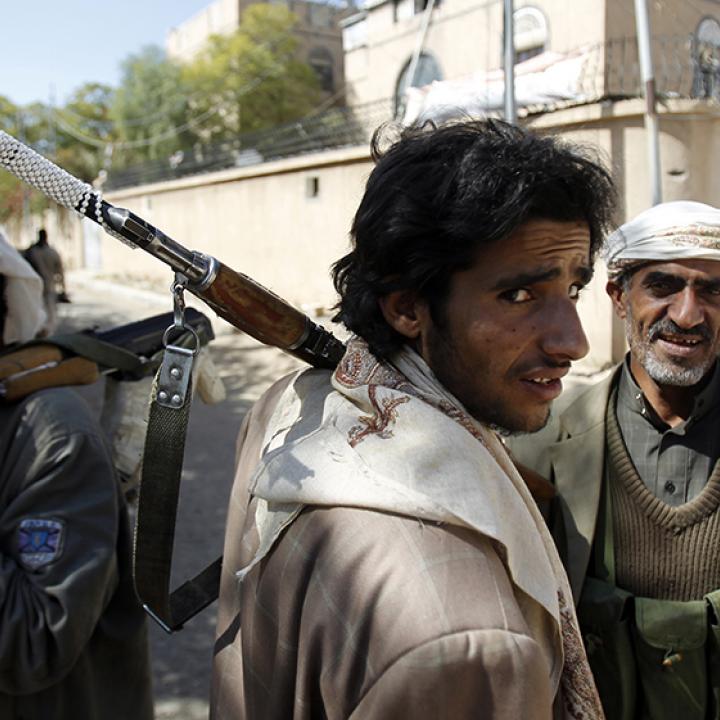
- Policy Analysis
- Articles & Op-Eds
The Tragedy of Yemen’s Civil Society

In times of crisis, individuals rise up to act as their society’s conscience. These individuals work to alert the international community to human rights violations or work tirelessly to help their community recover from major obstacles, natural or man-made.
These protectors are civil society activists, community mobilizers, and independent journalists. The best of this group are on a continuous mission to uncover injustice and rebuild communities. Unfortunately, through this activism these individuals become a constant target for those benefiting most from the conflicts that these protectors hope to end. And these pro-conflict parties’ considerable abilities to disrupt both civil society and the fortunes of an entire people are clearly visible in today’s Yemen.
As it is, Yemen’s civil society is still in its infancy, but its short history demonstrates that Yemeni civil society had considerable promise before 2014. Historically, the south gained a greater amount of experience in developing civil society organizations through the socialist-based unions of the 1960s and 1970s. In the north and some of the eastern areas of Yemen, civil society primarily manifested itself as charities funded by religiously motivated donations.
It was in 1990 that Yemeni civil society began to develop into an organizational structure associated with the modern meaning of the term. The political environment after Yemeni unification on May 22, 1990 allowed for the creation of multiple political parties and various civil society organizations. By the late nineties there were more than 7000 civil society organization registered with the Ministry of Social Affairs, each receiving a small annual stipend from the government. During this period, many international organizations also began opening offices in Yemen and helped develop the trend of donor-led projects.
Some Yemeni organizations became stronger by mastering the art of fundraising while others simply faded away. After the initial flourishing of the 1990s, Yemen’s civil society evolved from local charities to national development-based projects. During this period, the diversity of civil society organizations expanded to include organizations specializing in issues relating to women, minorities, rural populations, young adults, children, press, water, sanitation, and even the environment. There was also a significant number of research centers and think tanks. And while many organizations remained loyal to their development agendas, others developed a rights’ based approach and a political focus.
Gradually, these politicized civil society organizations began to advocate for human rights and good governance. Needless to say, this shift in focus troubled the government, which had little interest in being held accountable for Yemen’s struggles. Instead, these groups developed parallel structures that began to advocate for Yemenis’ rights. By the early 2000s, there was a Children’s Parliament, regular civil society reports submitted to international organizations countering the official reports from the government, civil society delegates to the United Nations and various other international assemblies, and other examples of extra-governmental efforts to develop Yemeni society.
With Yemen’s Arab Spring convincing even more civil society organizations to focus on political issues, the civil society structure in Yemen continued to grow and flourish. By June 2014, there were 8,300 registered civil society organizations. Moreover, the worldwide media attention Yemen received after the 2011 Arab Spring and the rise of bilingual social media activists encouraged a new trend of civil society work that primarily conducted itself online. Individual activists, who either lived abroad or had been educated in western countries, led this movement at its inception and continue to do so despite Yemen’s current instability. These are adaptable communicators who know how to appeal to western audiences and who promote well thought out, advocacy-based initiatives. There is, however, a concern that many of these initiatives are disconnected from the reality of a majority of Yemenis. Nevertheless, in general this activism has put Yemen on the world’s agenda and highlights the issues of the Yemeni people. This online advocacy has demonstrated its usefulness and flexibility during this current period of conflict, since Yemen’s on-the-ground civil society organizations are finding it more and more difficult to operate.
Furthermore, the reality of Yemen’s instability today has forced development projects to take the back seat while local relief initiatives take on the brunt of the civil society work that now relates to the challenges of a country in crisis. Although some initiatives are backed by international humanitarian organizations, many of these local relief organizations appeared in a necessary response to the gaps left by a crumbling state.
Equally significant are those journalists and human rights activists who attempt to report on human rights violations and document this dark period of the country’s history. Both branches of civil society efforts currently operating on the ground—relief and journalism—are working in extremely dangerous conditions and are a target for those who want the conflict to continue unchecked. Internal conflict within the civil society structure is also significantly weakening the success and progress of both individual institutions and civil society as a whole.
Without the violent war that has consumed the country from within during the last two years, Yemen’s civil society might have progressed considerably, providing an exemplary model to be replicated in other emerging democracies. Instead, Yemen’s current chaos has forced these organizations to either sink or swim without adequate preparation or groundwork. Many have already drowned, and although some groups have impressively survived through their tenacity, Yemen’s civil society has experienced a serious blow that erased two decades of effort and will continue to affect the post-conflict country for decades more.
Nadia al-Sakkaf is a journalist and former Yemeni information minister. Al-Sakkaf became the chief editor of the Yemen Times in 2005. This item was originally published on the Fikra Forum website.
Fikra Forum



